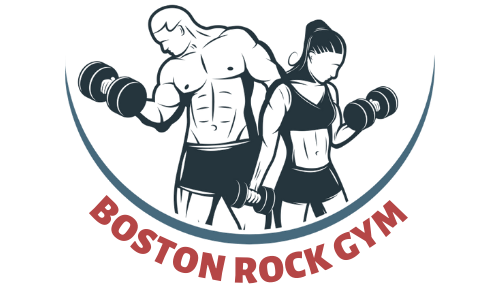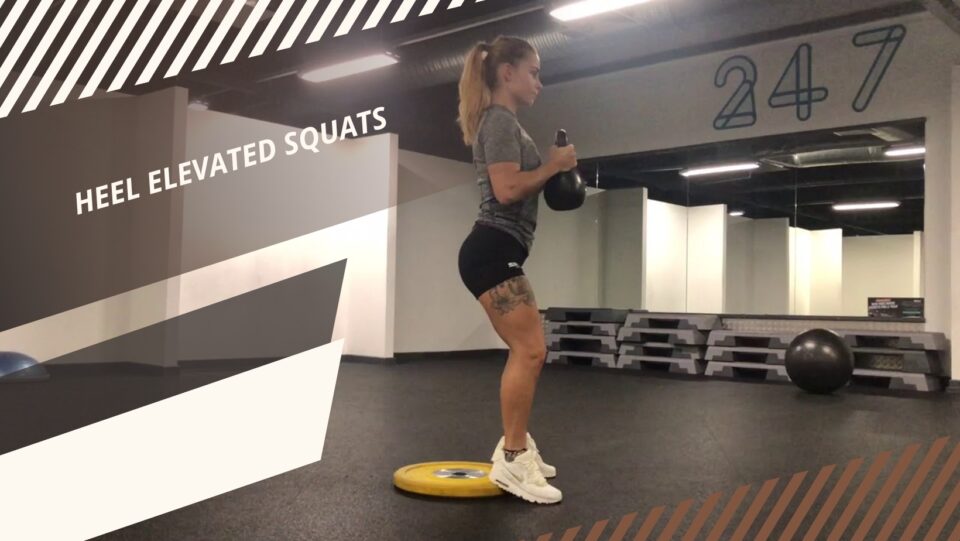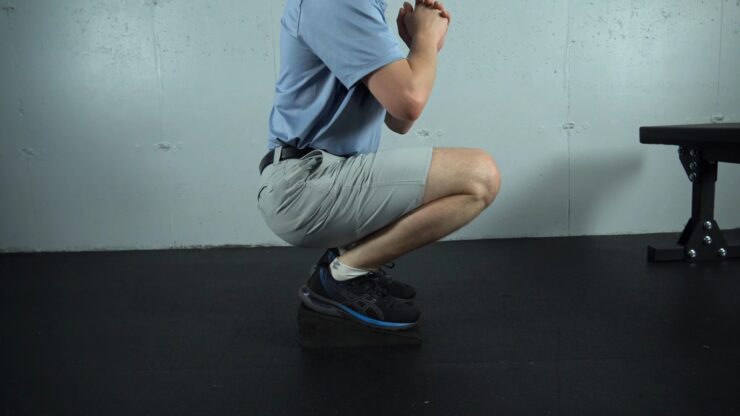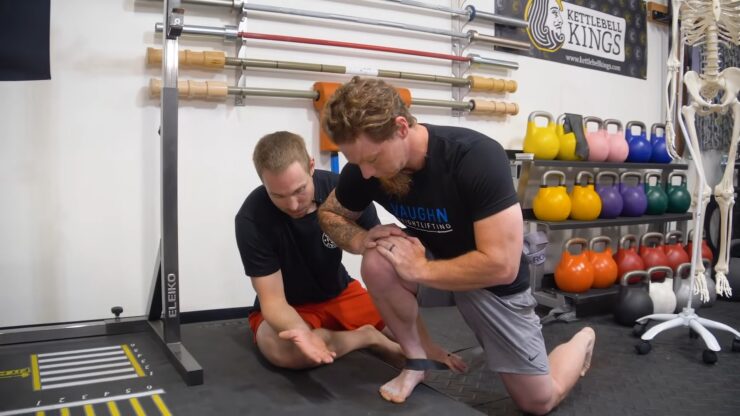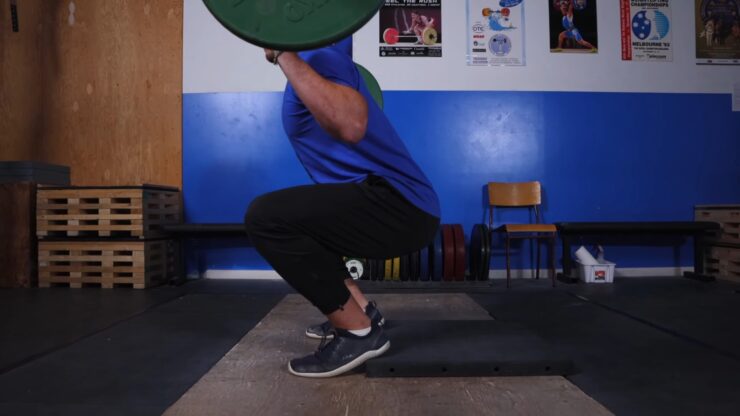For the majority of gym enthusiasts who seek to build muscle and enhance lower body strength, squatting is one of the most popular exercises.
With good technique, this fantastic compound exercise stimulates numerous muscle groups and burns a ton of calories. If you’re someone who wants to build muscle and learn more about squats, specifically heel-elevated squats, you came to the right place!
We’re here to inform you about everything you need to know about heel-elevated squats, including what they are, how they are done, and what benefits they provide. Let’s begin!
Contents
Heel Elevated Squats—Explained
Before we get into explaining the benefits of a heel-elevated squat, you should get acquainted with what this exercise actually is and how it is performed. You may confuse it with another exercise—the squat—which is why learning the difference is very important.
When doing a heel elevated squat, the heels are a little raised on an elevated surface, such as a weight plate or squat ramp. If users want to emphasize their quadriceps more or if their restricted ankle mobility prevents them from doing a deep squat, they can squat with their heels up.
The same advantages can be obtained by weightlifting or squat shoes with slightly raised heels. Due to a change in the center of gravity, heel-raised squats allow you to squat with a more upright stance.
This provides more knee extension than a traditional squat while also moving some weight burden away from the posterior chain and increasing quadriceps activation.
To attain a deeper squat while lessening stress on the ankle joints, lumbar spine, and hip flexors, people typically do an elevated heel squat.
Because it can assist with bettering squat technique and have a greater influence on muscle mass growth, a deep squat is more advantageous than a half squat.
If you don’t know how to perform heel-elevated squats, take a look at the list below to find out:
- Pick up some dumbbells, a weighted plate, or a squat wedge. With your toes on the ground and your feet slightly wider than hip-width apart (or as you generally position your feet while performing squats), stand with your heels on the plate or other item of your choosing
- Maintain an upright posture by carefully contracting your glutes and core. Taking a deep breath, start to lower yourself into a squat while keeping your weight properly distributed across your feet. When you do so, press your hips back as if you were ready to sit on a chair
- Leaping from the crown of your head, hold for one to three seconds, engage your core, and then exhale as you push through your feet to go back to the beginning position
- Do three sets of 10 repetitions
Muscles Worked With Heel Elevated Squats
Squats are unquestionably one of the best workouts you can perform for your lower body. It is a multi-joint, complicated exercise that works a lot of muscles at once and tolerates heavy loads, making it great for building strength and developing muscles.
It also has other benefits including enhancing bone density and calorie burning. The king of lower body exercises is the squat, the king of upper body workouts is the bench press, and the king of posterior chain exercises is the deadlift.
Squatting works your quadriceps and glutes, which are the major movers and key targets, as well as your hamstrings, adductors, abductors, calves, and lower back.
The muscles that support your joints are also highly crucial for stability. Your hamstrings, low back, spinal erectors, calves, abs, obliques, traps, and rhomboids are the stabilizing muscles during a squat.
As you can see, a lot of muscles are engaged. All of these muscles are also used when you perform a heel-elevated squat. The focus is now on your quadriceps instead of your posterior side (hamstrings and glutes).
Squats with your heels lifted are also less taxing on your low back since you can maintain a more upright posture.
Why You Should Do Heel Elevated Squats
More muscle fibers are recruited during a deeper squat, which results in increased strength and muscular development. But there is more than one reason to perform heel-elevated squats as well.
Heel-raised squats are frequently performed by individuals with no mobility issues simply because they effectively highlight the quadriceps, which may require more attention than a typical squat alone can provide.
To find out more about the advantages you can expect when doing heel-elevated squats, continue reading.
Heel Elevated Squates—Benefits
1. Improves Squat Depth
One of the biggest advantages of the elevated heels squat is that you can squat deeply since your ankles are in a better posture. In essence, it acts as a crutch to minimize the strain on the range of motion in the hips and ankles.
If your hips or ankles aren’t mobile, you’ll notice the change right away. The squat will allow you to lower yourself. You may increase both your size and your strength by using this wide range of motion.
The ideal stretching tension for your leg muscles, which is required to increase growth and strength, is provided as you lower yourself further into the squat.
Also, you may optimize your potential for developing your leg muscles by squatting as deep as you can.
2. Activates Quadriceps
One of the body’s major muscle groups, the quadriceps femoris, is made up of the rectus femoris, vastus medialis, vastus lateralis, and vastus intermedius.
Traditional back squats target almost all of the lower body’s muscles, particularly the posterior chain, but they don’t place much of an emphasis on the quadriceps.
Your quads may be significantly more activated by making a little modification, such as elevating your heels. It’s also important to remember that front squats, which involve holding the weight in front of you, move the burden to the anterior chain (muscles to the front of the legs).
To broaden the knee’s range of motion, you can try combining a front squat with an elevated heel.
3. Improves Stability
Heel-elevated squats can assist you in maintaining stability because squats can upset your body’s equilibrium and cause injuries.
This is especially true if you are wearing the proper shoes. In attempting to maintain stability, it could be challenging to lift your heels.
It’s a good idea to start off with shoes designed for weightlifting, which have a raised heel, and then switch to regular shoes after some practice.
You can maintain your balance and squat deeper thanks to the weightlifting shoes’ reduced strain on your heels.
4. Enhances Strenght
During squatting, more stability usually translates into the capacity to exert more force and power. It is only one of the numerous reasons it is not advisable to squat on shaky surfaces.
While squatting in shoes with increased heels as opposed to flat ones, we observe increases in average eccentric power. If you want to get the maximum strength and stability out of heel-up squats, it’s critical to do them correctly.
Use the entire force of your squat when you are in a solid position and standing on a sturdy surface. Never perform heel-up squats on an uneven surface since it might lead you to lose balance and injure yourself.
5. Reduces the Stress on Your Back
Lower back and lumbar spine injuries can result from squats, particularly when the exercise is deep and heavy, and your technique is not perfect.
Due to the fact that your upper body is much more upright during the squat, raised heel squats lessen this tension.
The risk of your back arching is less of a concern. This is due to the fact that your hips won’t be forced as far back and your knees will be above your toes.
This enables you to maintain a straight upper body, which relieves pressure on the lumbar spine and eases tension in the lower back muscles.
This not only prevents lower back problems, but it can also be a useful choice for those who want to squat but are concerned about re-injuring their lower back.
If your lower back hurts after performing sets of ordinary squats, it stands to reason for some to switch to heel-raised squats.
By doing so, you may be able to put less strain on your low back while doing more work on your legs. Your low back will frequently get tired before your quads do.
Conclusion
While executing a squat, placing something beneath your heels can assist individuals squat deeper and, because the load tension is moved to the front and they can go through a wider range of motion at the knees, it can also help more experienced lifters focus on their quadriceps.
The only ones who should avoid performing heel-elevated squats are those who have knee problems. In such instances, you should consult your doctor or another professional and get properly informed about what exercises you should and shouldn’t do to help your condition.
